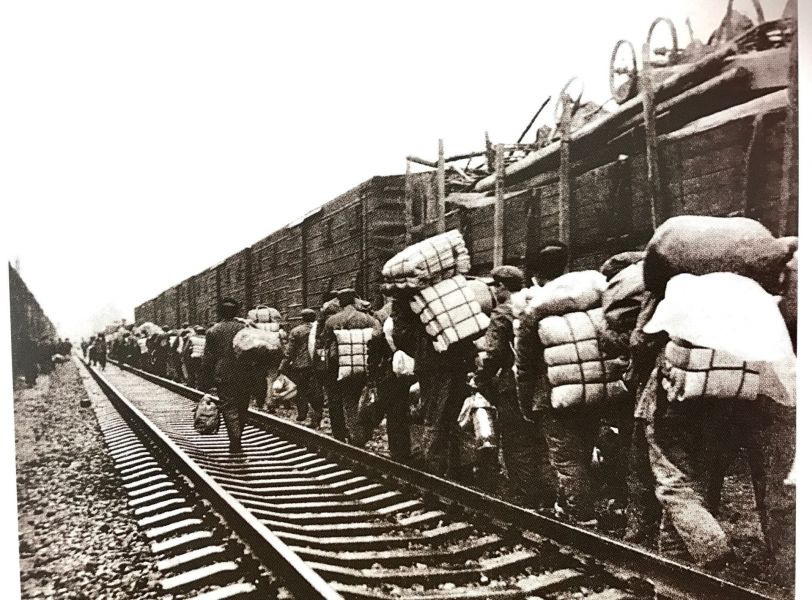
From the Third Front to the Second Line: The Construction Soldiers of Shenzhen
Shenzhen is a migrant city, and every migrant must cross multiple borders—physical and administrative, social and cultural—to fully belong in the city. The 20,000 members of the People’s Liberation Army (PLA) Engineering Corps (中国人民解放军基本建设工程兵), who arrived in Shenzhen between 1979 and 1982, were the earliest and largest batch of state-sponsored migrants during Reform and Opening Up. They repeatedly crossed geographical and metaphorical boundaries throughout their long journeys. The majority of soldiers came from secret or semi-secret heavy industrial sites in what was known as the Third Front (三线)—landlocked regions such as Guizhou, Gansu, Ningxia, and Qinghai (AMCPLA 2015: 21). These regions played a key role in Mao Zedong’s Third Front campaign—an economic strategy launched in the mid-1960s to strengthen China’s national defence as well as to address the regional disparity between the Pacific-facing coast and the underdeveloped interior (Meyskens 2020). In Shenzhen, the corps’ skills, originally developed to serve the military industrial complex, were adapted for the construction of civilian infrastructure, including transportation, water supply and sewerage, and public and commercial buildings. They assisted the border guards from the People’s Armed Police with erecting wired fences along the ‘Second Line’ (二线关)—the internal border separating the Shenzhen Special Economic Zone (SEZ) from the Chinese ‘inland’ (内地) (Ma and Blackwell 2017; Southern Weekend 2018). They built landmarks that represented Shenzhen’s rapid growth, including the 20-storey Shenzhen Electronics Building and the 53-storey International Trade Centre (Du 2020: 167–70). But since their demobilisation in 1983, the ex-servicemen have benefited unevenly from Shenzhen’s metropolitan development, arriving at drastically different levels of material wellbeing. This essay traces the PLA Engineering Corps’ trajectory from the Third Front to the Second Line and their transformation from Mao’s soldiers to Deng Xiaoping’s market actors. It delineates the various borders—between the hinterland and the coast, the rural and the urban, the military and the civilian, the socialist planned economy and the capitalist market, and the winners and losers of China’s economic transition—that they both crossed and constructed.
Maoist Motto, Dengist Design
By mobilising the Engineering Corps to participate in the civilian economy in Shenzhen, the Deng administration repurposed the builders of the Maoist militarised command economy to lay the groundwork for marketisation. The PLA Engineering Corps was established in 1966 for the purpose of industrialising inland regions to protect China from perceived threats from the Soviet Union and the United States. Between 1966 and 1978, various regiments of the corps carried out projects such as the construction of the China–Pakistan Friendship Highway, the exploration for and extraction of uranium and gold in Xinjiang, and the building of oil and gas industries in the northeast and hydropower plants in the southwest (AMCPLA 2015: 28). However, in 1979, the Engineering Corps was operating under capacity due to a redirection of Chinese macroeconomic policies and a contraction of infrastructural investment. Meanwhile, in March 1983, Deng announced the decision to downsize the military in an effort to professionalise the PLA. To minimise the army’s involvement in civilian affairs, the Engineering Corps was the first division to be demobilised (AMCPLA 2015: 584).
In 1979, Gu Mu, the director of the State Council’s SEZ Office and the political commissioner of the PLA Engineering Corps, ordered the transfer of troops to Shenzhen to ‘kill two birds with one stone’: to channel the Engineering Corps out of active military duty and build infrastructure quickly and economically in the city. Whereas the Third Front construction projects were stalled, infrastructure building became an urgent issue in Shenzhen (Duan 2018: 2). The new city’s geographical precursor, Bao’an County, was an impoverished border region best known as the gateway for illegal migration to Hong Kong. In 1980, the State Council created the Shenzhen SEZ and encouraged foreign investors to establish enterprises there. However, despite the allure of this new policy, the continuous flight of young, able-bodied males to Hong Kong meant Shenzhen lacked both the physical infrastructure to support economic production and the manpower to build it. After their arrival in Shenzhen, the PLA Engineering Corps jokingly codenamed the remaining residents—most of them women, children, and the elderly—as Division 386199 because, in the Chinese calendar, Women’s Day is on 8 March, Children’s Day is on 1 June, and the Chongyang Festival, which honours the elderly, is on 9 September (Liu 2013: 20).
During the Mao era, the Engineering Corps was a highly disciplined and efficient labour force, known for their endurance under harsh working conditions. As this militarised labour transplanted the same engineering techniques and work style from the Third Front to the SEZ, ‘Mao’s invisible hand’ extended its reach to the forefront of China’s market reforms (Perry and Heilmann 2011). The Maoist norms of asceticism and putting work ahead of one’s livelihood prepared the construction soldiers for their primitive living conditions in Shenzhen. The Engineering Corps slept in temporary bamboo huts set up at the construction sites, which barely protected them from subtropical downpours and heat and were frequently invaded by armies of rats, snakes, lizards, and mosquitoes (Du 2020: 163; Ma Chengli, Interview by author, 2019). Back in the interior, the soldiers had procured their own food and water by making use of local resources. The same principles of self-reliance and self-sufficiency guided the Engineering Corps in Shenzhen, as they recycled water from kitchens to outhouses and ate wild animals such as snakes (Meyskens 2020: 131; Liao 2003: vol. 1, pp. 48, 55). At the Third Front as well as in Shenzhen, intensive manual labour made up for the absence of modern machinery. When unclogging a sewer line in Shenzhen’s city centre, the soldiers relied on basic tools such as shovels and pickaxes and, in particular, their bare hands (Meyskens 2020: 131–33; Shenzhen Museum 1999: 77).
In Shenzhen, the Engineering Corps continued to use militarised language to describe their construction of civilian infrastructure; they compared the construction site to a battlefield, equipment to weapons, and referred to themselves as ‘seasoned soldiers fighting on the frontier of Reform and Opening Up’ (战斗在改革开放前沿的老兵) (Meyskens 2020: 172; Liao 2003: vol. 1, p. 90). Despite the apparent mismatch between the soldiers’ Mao-style rhetoric and the profit-seeking rationale prevalent in reform-era Shenzhen, the PLA Engineering Corps served as a human buffer mediating the relationship between China and global capitalism. Although Deng resolved to put an end to the excessive ideological campaigns under Mao, he was ‘determined to prevent political relaxation from leading the country to “bourgeois liberalization”’ (Zhang 2015: 169). Similar to the communist cadres from the Southbound Work Team who arrived in Guangdong from northern China in the 1950s, the Engineering Corps members were reliable and trusted agents who embodied ‘Deng’s socialist spiritual civilization’ and helped ‘maintain China’s communist heritage while pursuing needed economic reforms’ (Vogel 1969: 51; Zhang 2015: 169). In Shenzhen, the PLA Engineering Corps was on a mission not only to build the physical infrastructure but also to consolidate the Party’s authority at a remote outpost populated by ‘worldly’ Cantonese connected to Hong Kong through time-honoured clan and lineage ties (Vogel 1969: 21). Denise Ho’s introductory essay in this special issue demonstrates that the borderland between Bao’an and Hong Kong has been a ‘palimpsest’ shaped by centuries of social, cultural, and economic exchanges. Yet this rich history did not colour the Engineering Corps’ perception of Shenzhen as barren before their arrival. As Mary Ann O’Donnell (1999: 357) points out, the political discourses of these soldier pathbreakers played as much of a role as their labour in setting the horizon for Shenzhen’s development.
The Wrath of the ‘Pathbreaking Ox’
In 1983, the Engineering Corps was dismissed. At the initial stage of their demobilisation, the Shenzhen Government offered the veterans state-sector jobs, public housing, and urban household registration (hukou) (Duan 2018: 42–45). Among the 20,000 Engineering Corps in Shenzhen, around 8,000 Communist Party cadres were recruited by the Municipal Government; the remaining 12,000 were employed by a new state-owned enterprise (SOE) named SEZ Construction Company (特区建设公司), which was later privatised and renamed Shenzhen Construction Group (深圳建设集团). The organisational structure of the Engineering Corps was preserved in the new cooperative framework: different regiments were transformed into subsidiary companies under the Shenzhen Construction Group in a wholesale fashion. For instance, Regiment No. 1 became Shenzhen No. 1 Construction Company, Regiment No. 16 became Shenzhen No. 2 Construction Company, and the political commissioners or regimental commanders were reappointed as general managers (AMCPLA 2015: 605). Despite the stability of their personnel composition, these repackaged entities received significantly reduced financial support from the state and faced fierce competition in the construction market (Liao 2003: vol. 1, 72–73).
To compete against private operators from all over China, the demobilised Engineering Corps reassembled their Maoist ethics and ‘guerilla-style’ management (Perry and Heilmann 2011: 7). One commander turned CEO concludes that the demobilised Engineering Corps’ greatest advantage was that its members ‘are soldiers and remain soldiers even after taking off their military uniforms [that is, after being formally dismissed]. The troops remain well coordinated, highly disciplined, and tightly managed’ (Liao 2003: vol. 1, p. 98). In the past, under the shadow of possible military conflicts between China and its Cold War rivals, the construction soldiers developed a combat style of round-the-clock operation. As civilian employees, they continued to exert themselves to the extreme to meet the demanding deadlines during Shenzhen’s infrastructure boom in the early 1980s—sleeping and working on construction sites during ‘wars of annihilation’ (歼灭战), while applying the ‘huge-crowd strategy’ (人海战术) to overcome technical deficiencies with large labour brigades working like ‘ants gnawing on a bone’ (蚂蚁啃骨头) (Liao 2003: vol. 1, 38–43, 171). When erecting the Second Line, the demobilised soldiers used their muscle power to transport railings weighing 700–800 kilograms uphill (Southern Weekend 2018).
In the eyes of the former corps members, the ‘good tradition of the PLA’—soldiers being altruistic, honest, righteous, concerned about long-term public goods rather than short-term personal monetary interests—contributed to both their successes and their setbacks (Liao 2003: vol. 1, 71, 214). In 1986, the construction sector in Shenzhen was hit hard by a recession, leading to economic difficulties among the former soldiers (Du 2020: 180). When Shenzhen experimented with a tender bidding system, the financial structure of the SOEs as well as the veterans’ mentality prevented them from offering bribery or entertainment to the bid issuers or the brokers, putting them in a disadvantageous position compared with more flexible private enterprises. A regiment commander turned general manager once asked a broker whether he had a receipt when the latter asked for a 3 per cent kickback for a 150-million-yuan project. Baffled by this naive request, the contractor left, and the business was gone (Duan 2018: 215). Many demobilised construction soldiers felt betrayed because the Shenzhen Government failed to honour its promise to grant their SOEs favourable consideration when assigning government-directed construction projects. The government later altered its policy of open tender bidding for all projects and reserved some special quotas for the veterans (Duan 2018: 133).
Yet this temporary relief scheme did not stop the state’s push to turn the SOEs into self-financing enterprises. After Deng’s Southern Tour in 1992, the SOEs started their transformation into shareholding companies. By 2005, all the SOEs from the restructured Engineering Corps had been corporatised. One real estate company, Jian’an Group—considered to be of great strategic value—remains today under the control of the central government. The remaining companies have either been sold to their leaders through the management buyout process or become hybrid firms with varying degrees of private ownership. Operations not considered as having core production functions but providing social welfare, such as small factories built for the corps’ family dependants (家属厂), have been shut (PLA Engineering Corps Memory and History Materials Compilation Group 2015). The privatisation process widened the gap between rich and poor among the former construction soldiers and resulted in unsettled disputes and discontent that persist today. In the course of converting public enterprises into private property, members of the Engineering Corps in leadership positions or new entrepreneurial elites with connections took the opportunity to enrich themselves through insider dealing. In contrast, the relatively less-educated, lower-skilled employees were laid off with lump-sum payments that monetised their past services (买断).
The construction soldiers’ varied experiences reflect the complex relationship between the previous socialist and the present market economy in China; their individual biographies are intertwined with China’s marketisation under the influence of rising neoliberalism worldwide. In November 2005, more than 3,000 demobilised construction soldiers, angry with the meagre buyouts offered by the privatising SOEs, organised a sit-in outside the Shenzhen Municipal Government building and were ultimately dispersed by riot police (SCMP Reporter 2005). They targeted the city government not only because it represented state power, but also because the office compound was where a famous statue of a ‘pathbreaking ox’ (拓荒牛) was located. The PLA Engineering Corps identify the pathbreaking ox as their icon and distinguish themselves from Shenzhen’s economic migrants who came to the city of their own accord. Having arrived in Shenzhen at a time when the city’s future was uncertain and its status very low in the spatial hierarchy of China, the construction soldiers believe they deserved preferential treatment from the state as firstcomers. Yet not every former construction soldier received material benefits that met such expectations. Those insufficiently compensated regard the changing reward mechanism from the 1970s to the present as unjust. When they were at the peak of their productivity, their income did not follow the market mechanism but was determined by state distribution; when their competitiveness on the labour market declined due to their age and low educational levels, they were expelled from the protective shell of the socialist system. Similar to the laid-off workers at industrial bases in the northeast, Shenzhen’s former construction soldiers felt left out of China’s economic liberalisation even though they built from scratch the very city that is emblematic of the success of reform (Lee 2007; Hurst 2009; Cho 2013). They, as individuals, have borne the social cost of China’s market transition.
Borders Within and Without
On their arrival in Shenzhen between 1979 and 1982, the construction soldiers were under strict orders to not wear their military uniforms to avoid triggering fear and suspicion on the part of the British. In contrast with the active-duty soldiers defending state borders via hard military means, the Engineering Corps served as the soft, human buffer at the Shenzhen–Hong Kong border, making the two places physically more similar but socially and culturally more different. In terms of urban development, they laid the foundation for Shenzhen’s rise as a city of skyscrapers resembling Hong Kong. In terms of demographics, their relocation doubled the population living within the SEZ (Du 2020: 163). The influx of Mandarin-speaking ex-servicemen—the ideal socialist subjects who had internalised the Mao-era ethos of collective good, hard work, and frugal living—in Shenzhen diluted the influence of the local Cantonese, Hakka, and other dialect–speaking communities with longstanding commercial and family ties with Hong Kong. This unique group of soldier migrants brought with them mentalities, a work ethic, and a sense of political belonging that constituted the social foundation for Shenzhen’s reformulation of its cross-border relations with Hong Kong under reform.
The transfer and long-term settlement of the PLA Engineering Corps in Shenzhen are an important bordering technique of the government of the People’s Republic of China; the lives of the construction soldiers after their demobilisation were shaped by the shifting boundaries of the urban–rural divide, social hierarchies, and economic inequalities within mainland China. All demobilised corps members who stayed in Shenzhen were offered urban household registration and assigned jobs in government agencies and SOEs. Compared with later cohorts of rural migrants, their status as legal city residents positioned them as privileged. However, during the SOE reforms, many veterans received inadequate financial support from the state given the sacrifices they had made. Their public protests in 2005, rather than turning them into an interest group that the city government must take into account, made them a ‘problematic population’ to be regulated for the sake of social stability. Once a core labour force of the militarised command economy under Mao, the construction soldiers were transferred to the geographical edge of the socialist state in the late 1970s and early 1980s; as Shenzhen became central to the state’s representation and management of reform, many demobilised corps members were increasingly marginalised. They faced the painful irony of being excluded from the new economic opportunities inside the boundaries they helped build.
Today, the demobilised PLA Engineering Corps members are a heterogeneous group. Among them are creative and daring entrepreneurs such as Ren Zhengfei, the CEO of Huawei, the world’s largest telecommunications equipment manufacturer (Duan 2014: 3–26). Wang Ju and Jiang Zunyu, two high-ranking Shenzhen government officials fallen from grace due to corruption charges, are also former construction soldiers. Yet, beyond the success stories, veterans with low levels of educational attainment have experienced downward social mobility. According to my interviews, those who have retired comfortably believe that their former colleagues complaining about unfair treatment are only experiencing ‘mild’ economic difficulties and have ‘brought misfortune on themselves’ due to accidents, health problems, or divorces. By denying structural reasons for their grievances, such as how illnesses result from a lack of workplace safety and family separations were brought about by long-distance relations during the early years of market transition, the winners of China’s reform replicate the state’s narrative of market triumphalism. In light of the unstable cohesiveness among the former construction soldiers, one might argue that an internal border is emerging among this group after they crossed many borders together in the past as comrades-in-arms.





